by Josh Evans
I like tea. I like how one plant becomes many different kinds of drink. I like that one can cultivate the craft of brewing it, as well as just enjoy it simply. I like that it has rituals, and its psychotropic effects. I like that lots of other people like it, but not everyone likes it the same way.
This is a 3-years-long story about tea and tea-like non-teas. But it didn’t start with tea. It started—as more than a few of our projects do, it seems—with a fungus.
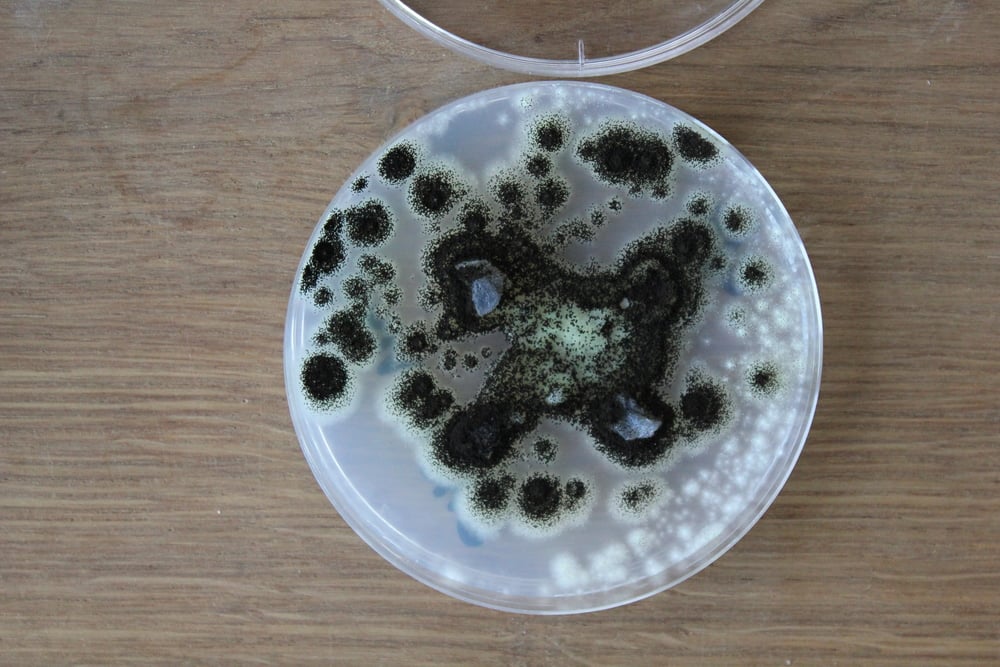
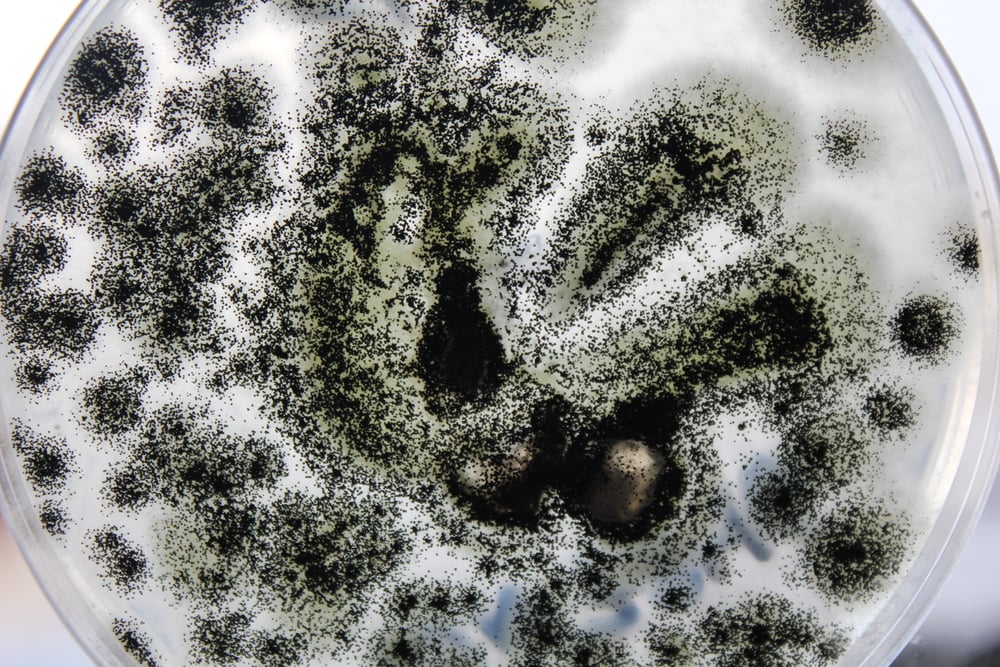
Part 1—A. niger and Pu-erh
Meet Aspergillus niger. Yes, it is part of the same genus as our homeboy A. oryzae. But the similarities largely stop there. While the koji mould is white, for example, this one, as its name suggests, is black. And while koji mould is used for making all sorts of fermented products like miso, soy sauce, sake, amazake, shio-koji, and others, A. niger occupies a very different edible niche. In many cases, actually, A. niger is seen as an agricultural pest. It’s quite ubiquitous across all sorts of soil samples. Yet for a certain type of tea called Pu-erh, produced in Yunnan province in the south of China, A. niger is one of the process’ key microorganisms.
Most teas, it turns out, are not strictly speaking ‘fermented’—that is, their transformations are not the result of microbial metabolism, but rather variations of oxidation, autonomic or enzymatically facilitated, modulated by physical techniques of wilting, steaming, panning, baking, rolling, drying and others in a great many combinations.
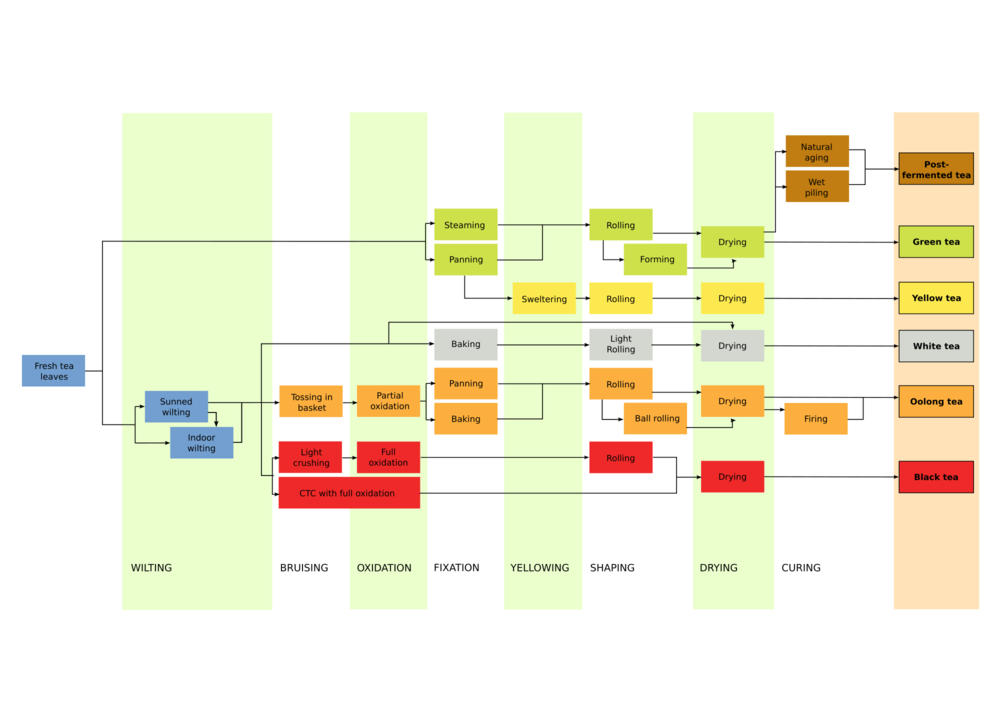
A flowchart of tea processing that simplifies a much more complex combinatorial range of methods. (Wikipedia)
That’s where the Pu-erh comes in. This tea does involve microbial metabolism—after undergoing some of the first steps that usually lead to green tea, the partly-processed leaves are heaped into piles and let to spontaneously ferment. A. niger comes to dominate and contributes prominently to its flavour, adding notes of earth, moss, and cellar to the mix (geosmin is one of its main secondary metabolites), while rounding astringency and smoothing bitterness. It brings a particular perspective to an already complex product—the result is something that, unlike many teas which begin to deteriorate as soon as their processing is complete, can be aged for ten, twenty, thirty years or more, increasing in complexity and nuance, and demanding even more when it comes to brewing and drinking it best. More like a wine than an olive oil. A pu-erh-obsessed friend of mine in Japan, Max McCurdy, brewed us some while I was in Tokyo in November 2014, after our insect field work. He had a tiny teapot, one that could fit into the palm of my hand; we only started drinking from the third brewing, and kept drinking until well after the tenth. It is, in my experience, a particularly convivial way of drinking tea, as it demands repeated motions of boiling, brewing, and pouring that become perfect punctuations in a long, slow-burning series of shared caffeinated jaunts.
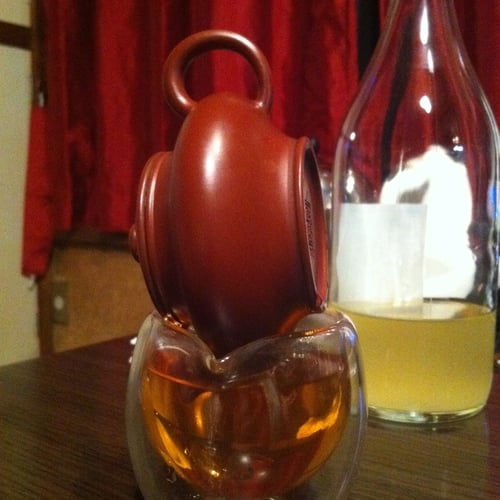
Max’s tiny pu-erh pot being drained for drinking
January 2013 is when I first started looking into microbial action in tea. Mycotoxicity in many fungal species can vary according to the strain and growth conditions, but with a bit of research I learned that A. niger is generally safe for human consumption (Blumenthal, 2004). I first met A. niger in person in February, after our friend and fellow fungal enthusiast Sara Landvik, a researcher at Novozymes, graciously agreed to plate me a couple known strains from their open collection. I propagated them on some standard PDA plates we had already prepared (petri dishes with a simple mixture of potato starch and dextrose in an agar gel), and planned the plants I would try to encourage the fungus to ferment into some sort of pu-erh-like tea.
Here are my notes from trials over the 2013 growing season.
12.2.13
I began with A. niger plated up by Sara Landvik, our friendly microbiologist at Novozymes, replated it to multiple plates, let it sporulate, then mixed the spores into sterilized water, and steeped dried verbena leaves in a small amount of liquid inoculum to coat and absorb.
They are now slowly drying.
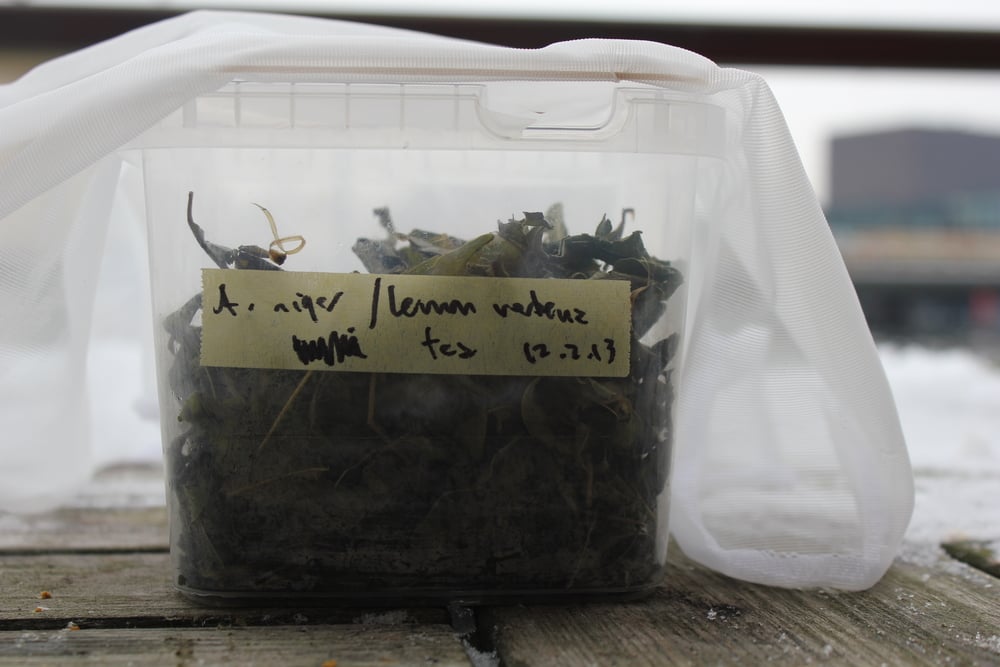
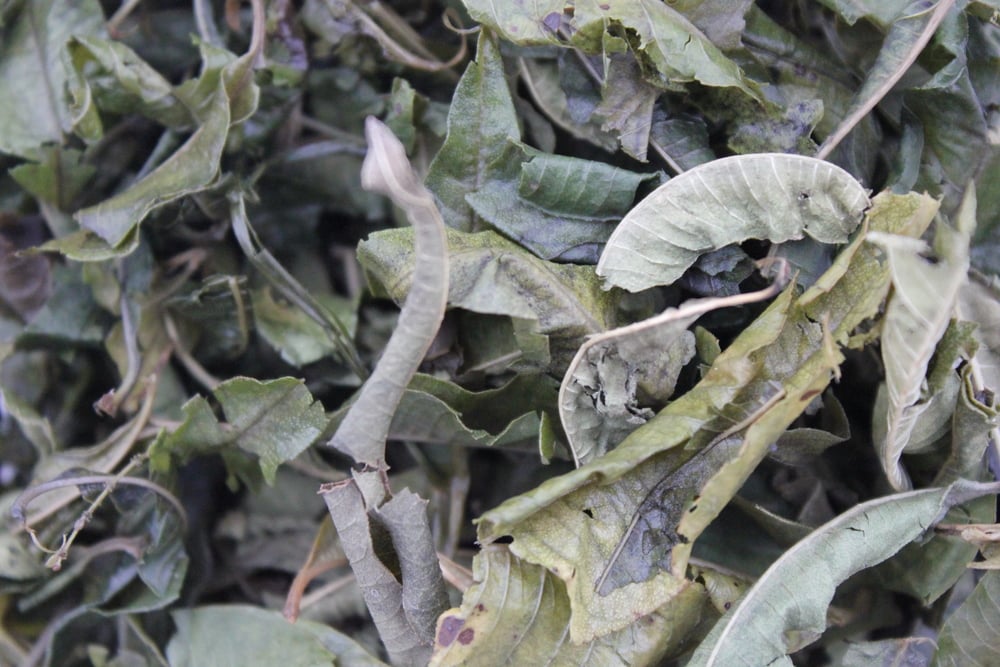
Lemon verbena pu-erh
8.7.13
The verbena pu-erh has been sitting for months and is still very fragrant – earthy and complex.
Now we are in the season of growth. I have begun trials with elderflower, jasmine, nettles, beach rose (pink and white), dittander (leaves and flowers). Going to look for fireweed (Chamerion angustifolium) – similarities to Camellia sinensis.
I’ve put the A. niger inoculum into an atomiser.
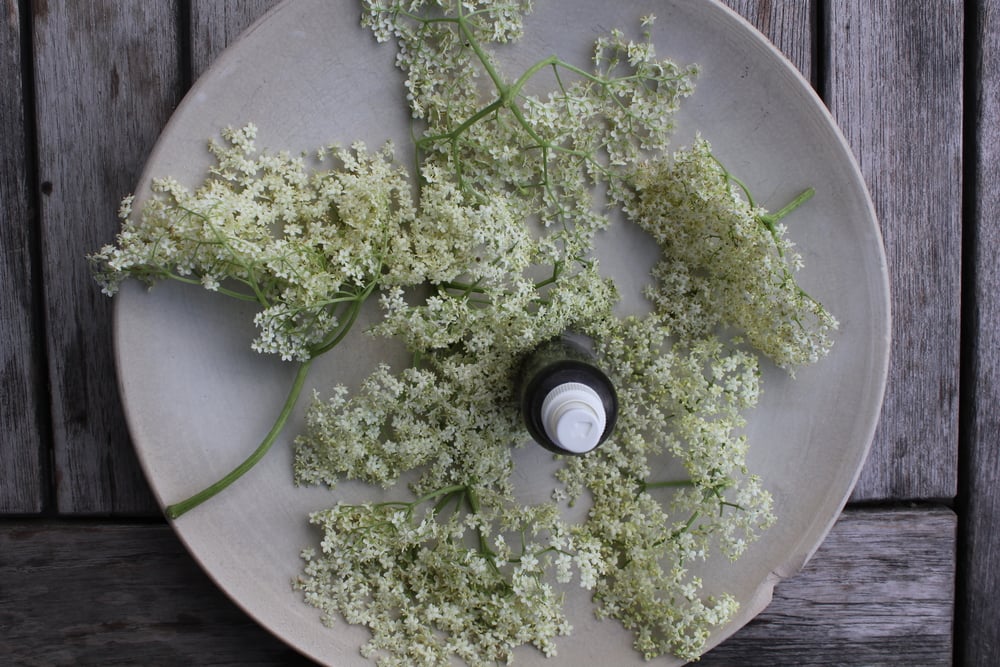
Elderflower (Sambucus nigra)

Elderflower – I sprayed some whole on the stem and also loose, and left it out at room temperature on a plate. I also blanched a few heads then inoculated and left them out. The blanched ones have turned a dark green with black tips and a stronger smell – the rupturing of the cells seems to enhance the enculturation, even beyond the oxidation.
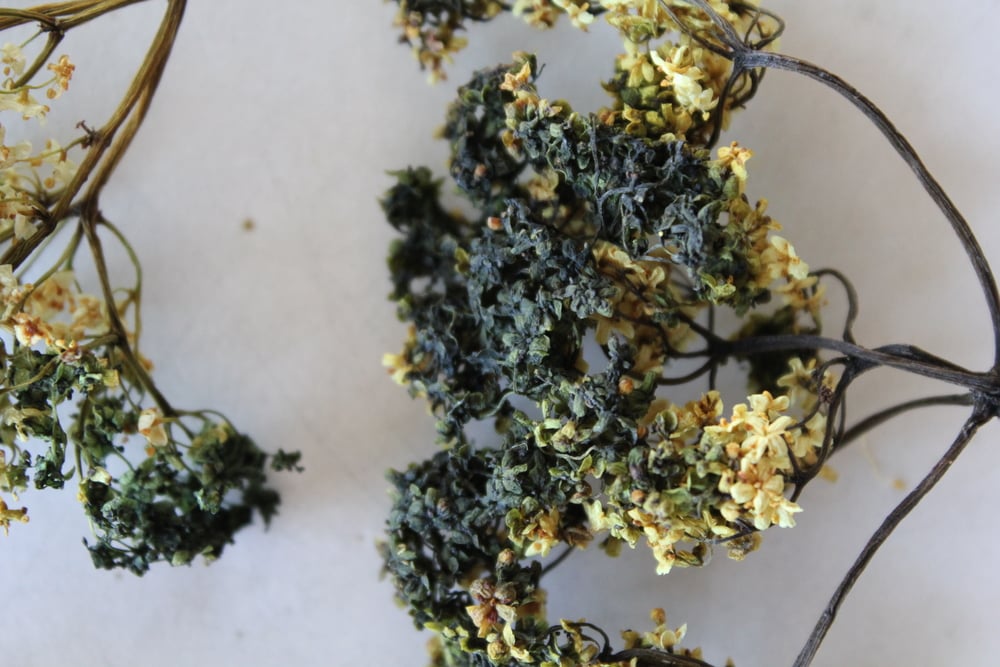
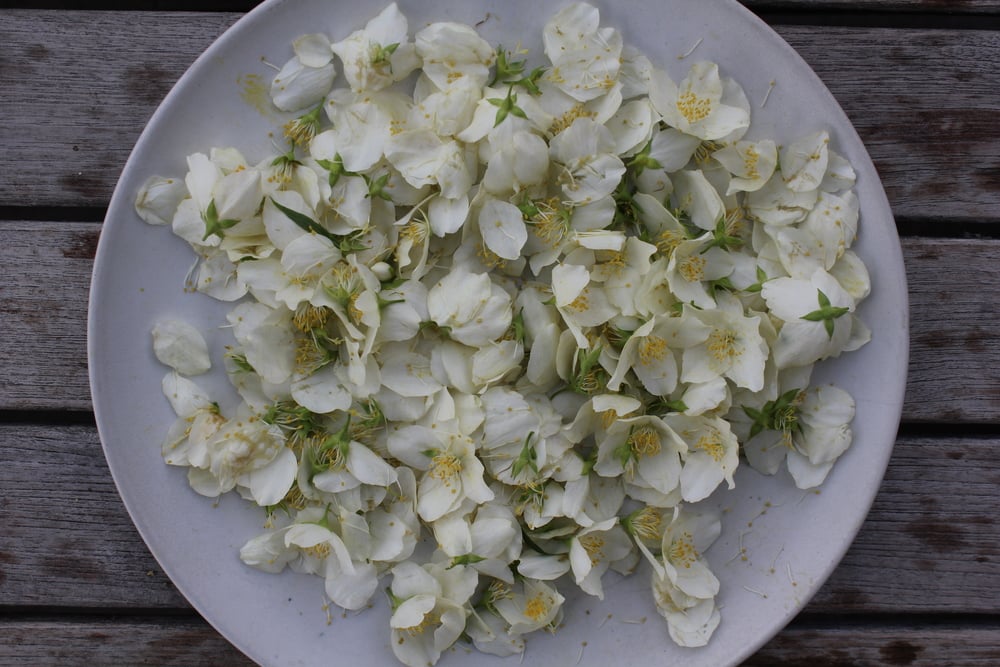
Jasmine
Jasmine – I harvested some jasmine from the tree at my house. Should figure out which species it is. Now with the more delicate flowers I have started using the vacuum packer to vacuum impregnate the cells with the liquid inoculum, instead of blanching. It also helps speed oxidation. After three days of drying the vacuum-impregnated flowers are noticeably darker and more aromatic.
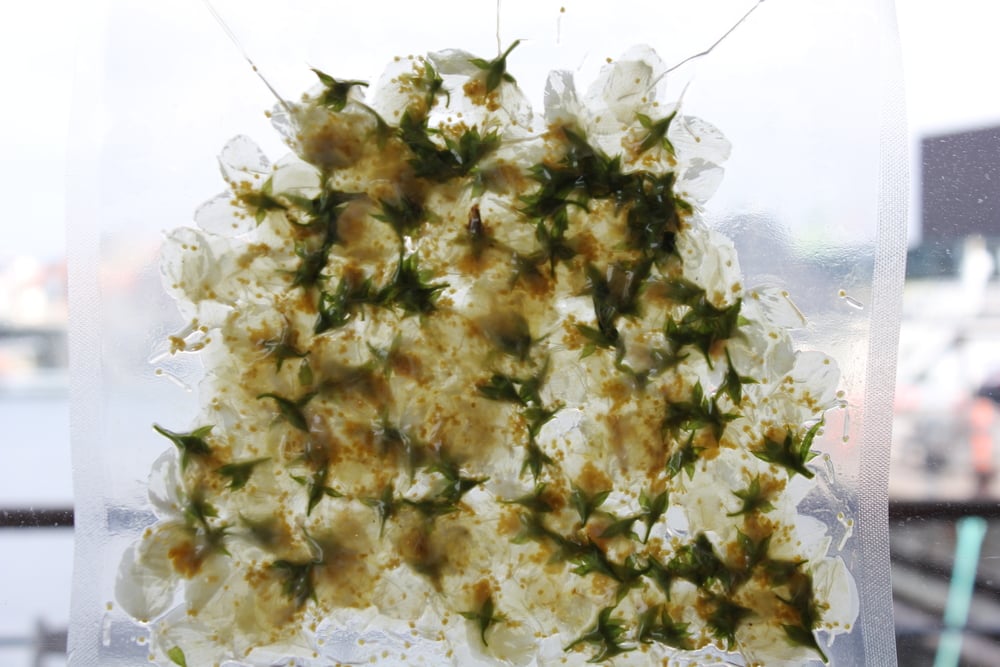
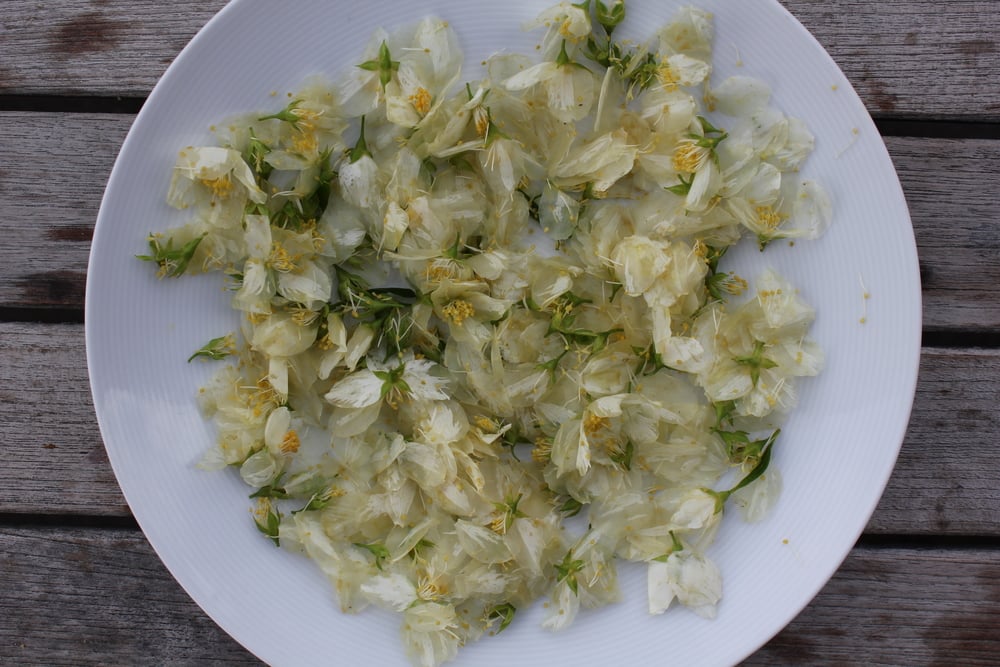
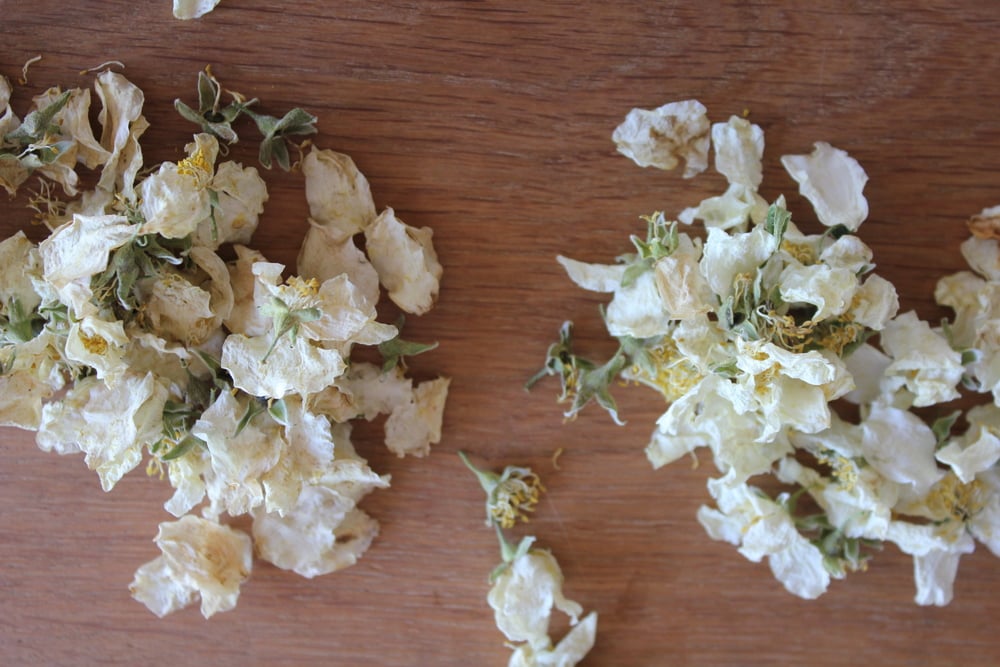
The compressed jasmine (L) became slightly darker and gained a deeper, smokier smell than the uncompressed (R).
Nettles – I rinsed dry whole nettle leaves in water to soften, then tossed them gently with the liquid inoculum.
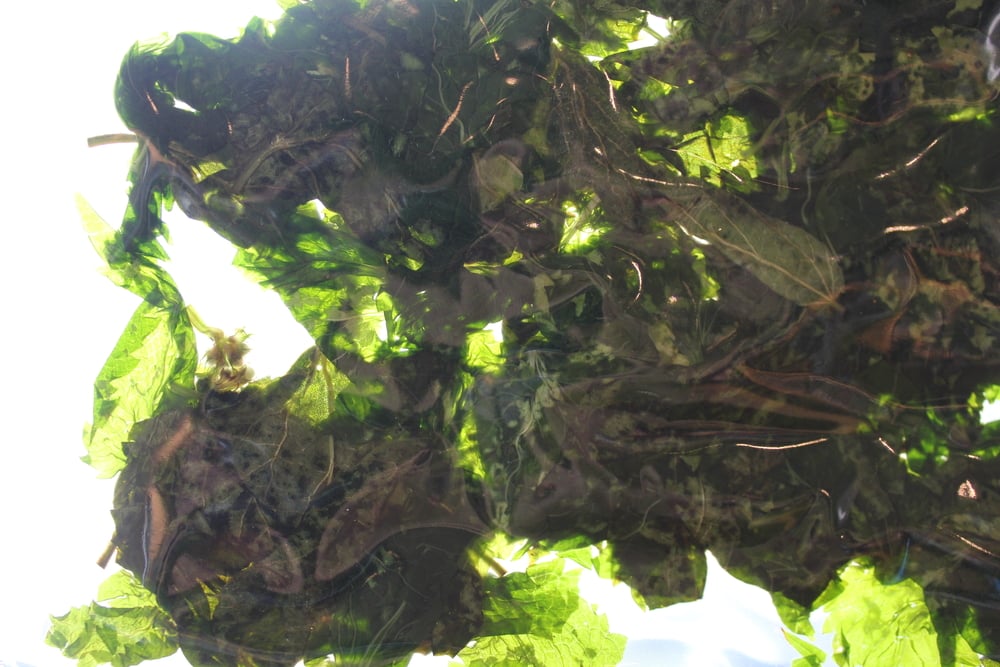
Nettles (Urtica dioica)
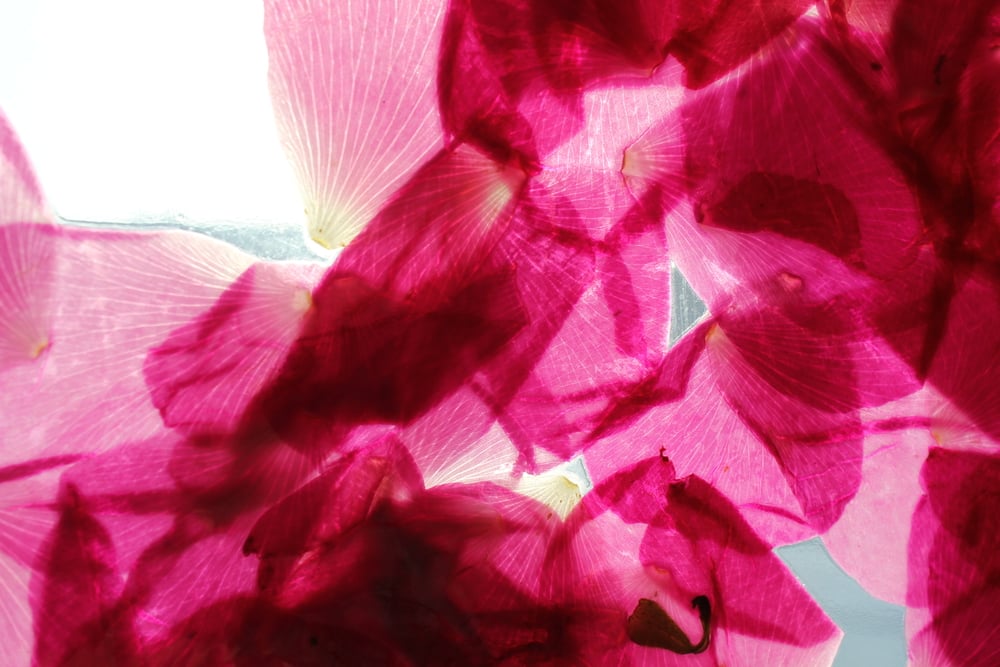
Beach rose (Rosa rugosa)
Beach rose – Pink and white. I separated loose petals and whole blossoms, and again did half just spray and half sprayed then vacuum impregnation. Not so much difference here yet but we will see.
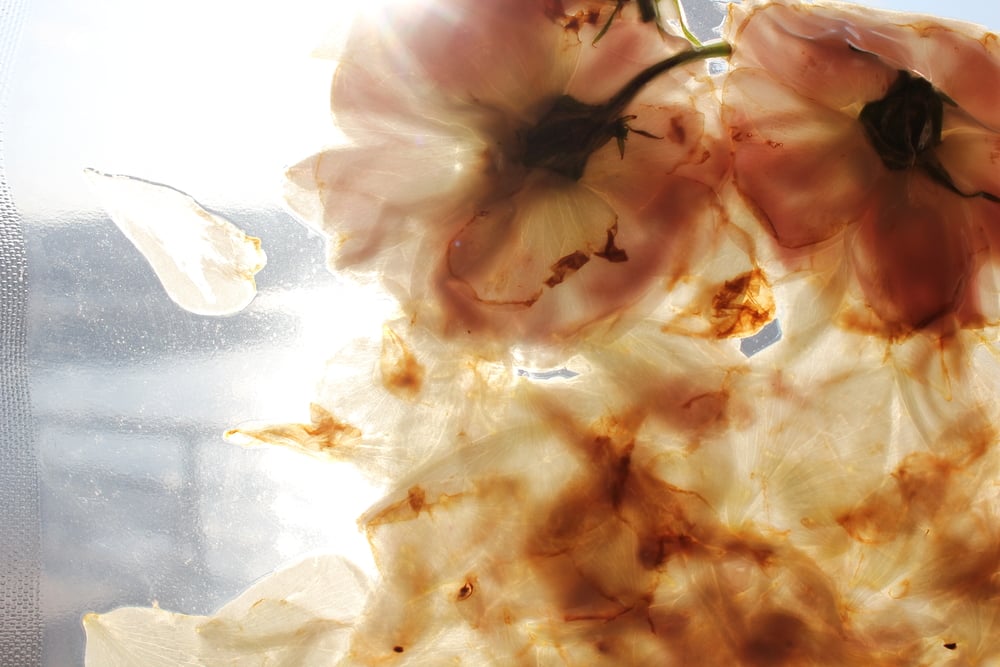
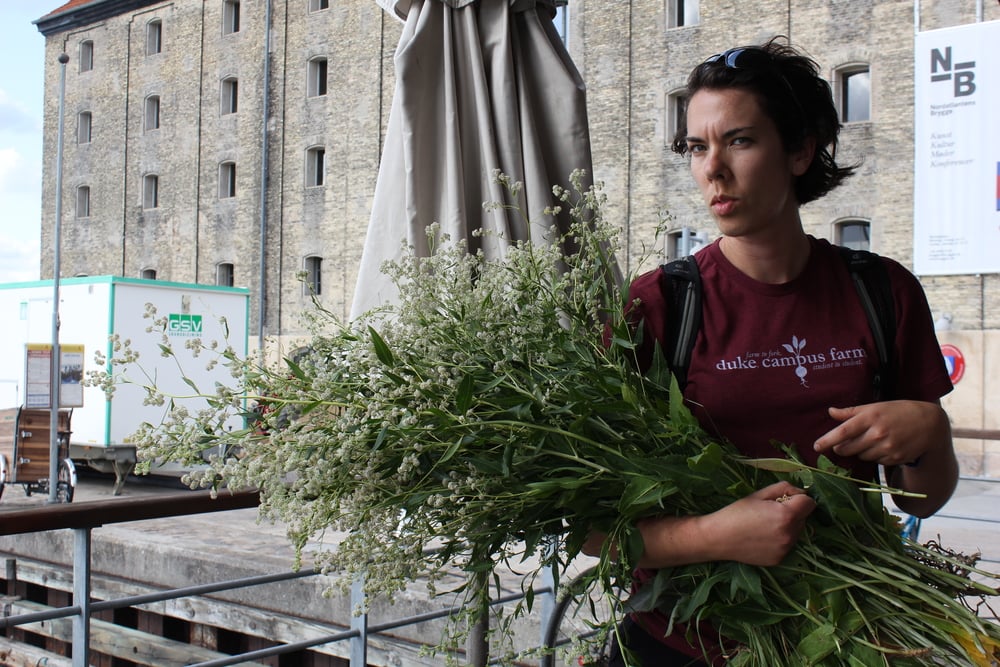
Justine with flowering dittander (Lepidium latifolium)
Dittander – the leaves and flowers are still drying – they are quite sturdy, perhaps too much so for this processing. The flowers smell mainly of hay. The leaves look somewhat promising – but next time I should rub them between my hands more vigorously to get the oxidation going, before continuing the process.
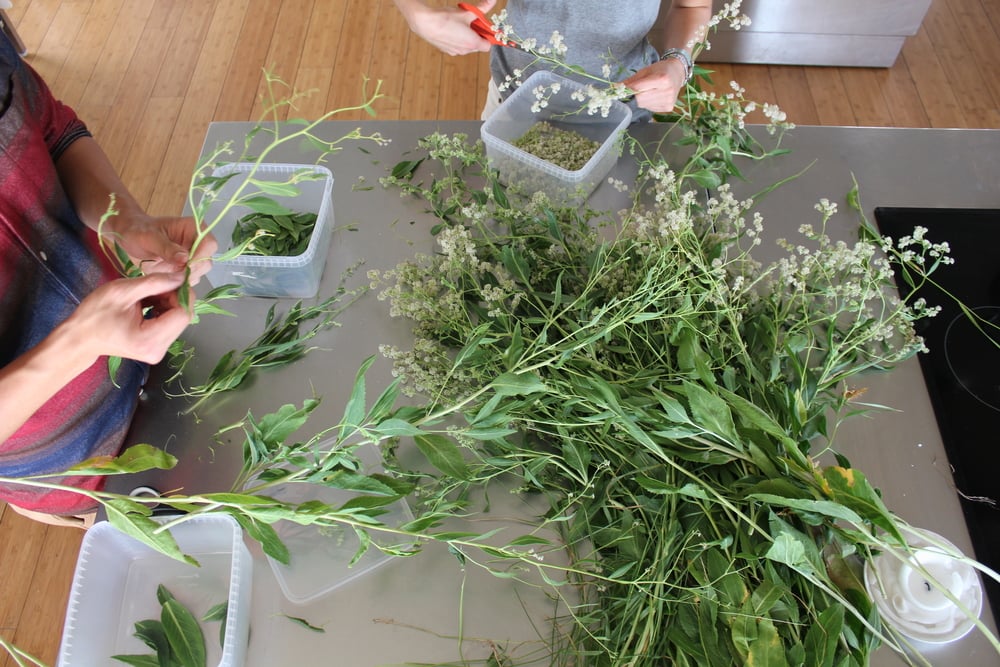
Processing the dittander
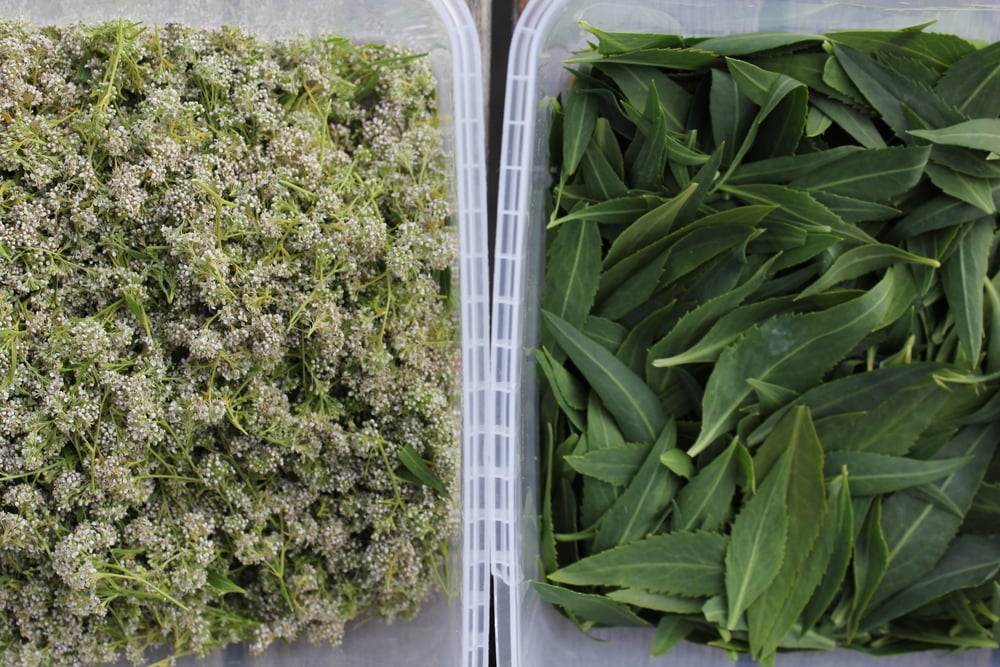
Dittander flowers and leaves
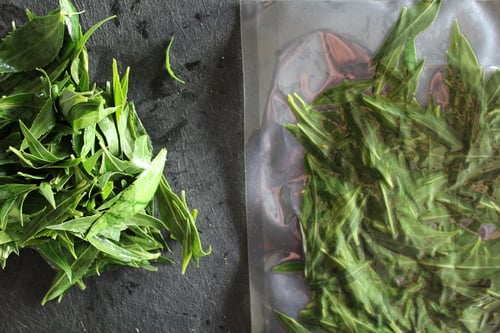
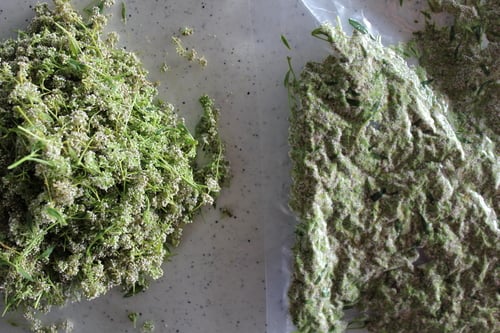
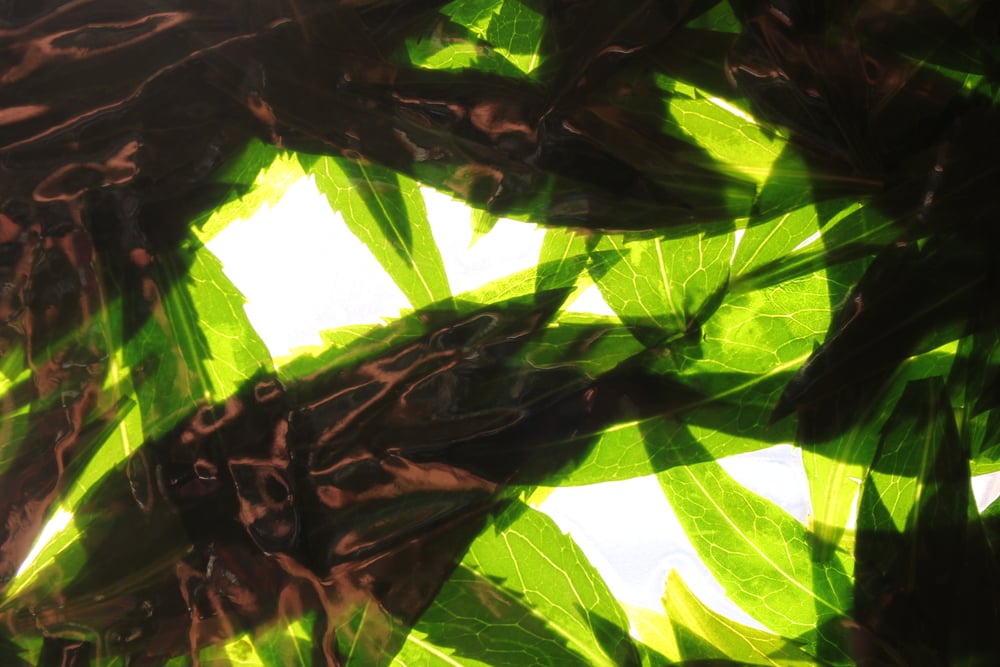
12.7.13
The flowers are becoming more fragrant.
The dittander doesn’t oxidise fully when bruised. It ends up just losing most of its pungency and drying out.
The nettles are promising – they oxidise very well, and gain fantastic aroma.

Finished nettle tea.
25.7.13
Justine found fireweed in Charlottenlund on Tuesday 23.7. I stripped the leaves that evening, rolled and pressed them to break the cells and begin the oxidation. I kept them in a plastic container until Thursday evening. They generated humidity and began smelling strongly: overripe mango, feijoa, curing apple, bubblegum, terpinic, guava, green, juicy fruit apple, hay, grass, summer, benzyl anthranilate (grapefruity/tropical flavours). Thursday evening I spread them out to dry and continue oxidising on the counter.
Friday morning I sealed them in vacuum bags to ferment anaerobically over the weekend.
The half kept in the box retained its fruity, berry aroma, while the one left to dry open had these fruity notes replaced with more green, fresh hay, green banana.
29.7.13
Both bags when opened smell strongly of olives and pickles – very lactic and savoury. This mellows quite quickly.
I split each batch (aired/sealed) into two, toasted half in a pan until just before crisp and the other steamed in the oven, both to halt the fermentation.
The toasted ones smell like: ‘roasted pineapple’ (Sarah), ‘herbaceous and green’ (Avery), ‘vinegar sauce’ (Justine), ‘sexy’/’arousing’ (Ben)
The steamed ones smell like: ‘banana’ (Sarah), ‘olives’/’some sort of piss’ (Justine), ‘capers’/’marine’/’piss’ (Ben)
The dittander has since turned into vomit; they can be forgotten.
4.10.13
Finally a sensory.
First the flowers – beach roses (white and pink), and jasmine. 1.2g/120ml water (80˚C), 4 min infusion. The roses are both weak and insipid, but the jasmine has potential – smells of old leather, smoke, old perfume. It is grown-up. A stronger extraction could help, and perhaps a tincture.
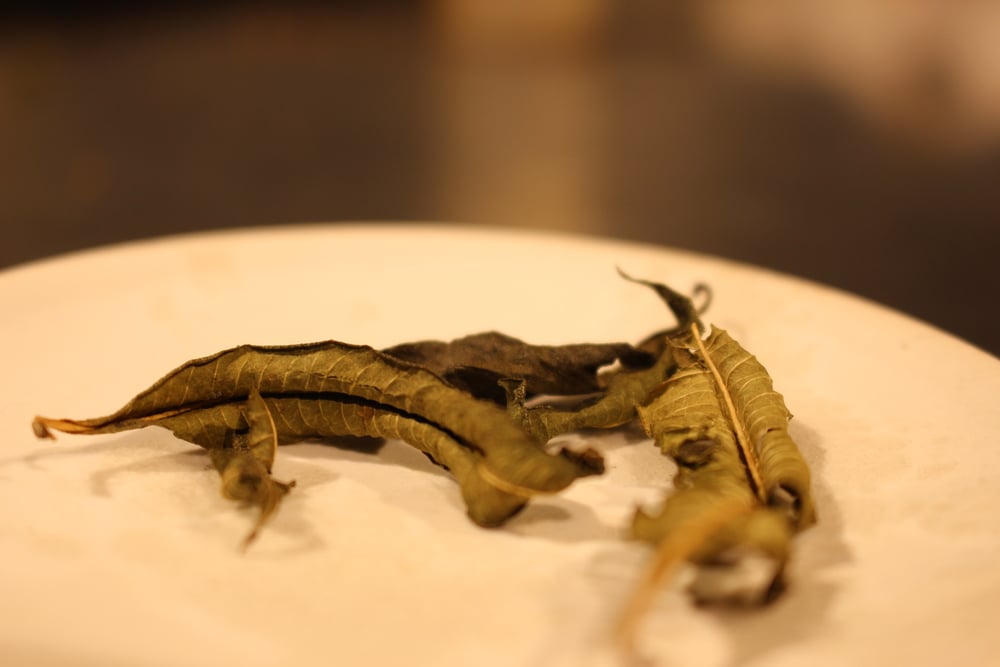
Lemon verbena was also worthwhile—its aromatic top notes became subdued and gained a grown-up richness not usually present in the herb, fresh or dried.
Next, the original lemon verbena. 2.4g/120ml water (80˚), 4 min. infusion. Multiple infusions as follows:
1st. Musty, woody, mouldy. It smells rounded, the similar sensation of smelling cold cream. The taste is unbalanced and fuzzy, not unpleasant but neither so pleasant.
2nd. It is stronger – leather, cedar; the mustiness accumulates with sips.
3rd. Smoother, rounder. This is good.
4th. Has body, grown up. The cedar comes forward.
5th. The sweetness of the verbena now really comes through, and the wood. It is brash, past. It will only weaken and simplify.
The third and fourth trials were the best.
The nettle became rich and savoury – successful, though perhaps more suited to a broth than a tea.
Then fireweed. There are six trials: two parameters of fermentation start (‘aired/sealed’) and stop (‘air-dried/steamed/toasted’).
The toasted ones are very smoky – only the second brewing was remotely palatable, the first too brash, the third already stale. Shall I toast differently?
I prefer the steamed – the air-dried are olivey, too vegetal. The steamed are delicate with good balance and light body for me.
Others liked the air-dried, perhaps for the particular aromas.
Overall I think I prefer the sealed ones – the flavour is stronger and more complex.
For next season, focus on fireweed, and inoculate with A. niger.
12.6.14
I learned from Sara that A. niger is fond of higher temperatures, 30-37˚C.
While some of these applications were interesting and potentially useful for something, they did not get at the heart of the matter—which is to say that I still wanted to drink some tea, and I wasn’t yet there.
Part 2—Fireweed
At this point I need to depart temporarily from pu-erh, and focus in on fireweed. Ben had found an entry in a Swedish herbal about how people used to make tea from fireweed, and sent it my way. I made first fireweed trials that summer of 2013, and promptly fell down the fireweed hole.
It turns out fireweed has quite a lot to do (culturally at least) with the tea plant, that is, Camellia sinensis. Fireweed tea was also called Koporye tea in Russia, after the area of Koporye west of St. Petersburg near the Gulf of Finland, where in the 1800s producing fireweed tea was the main source of income. Inhabitants of this region even burned forest in order to stimulate the growth of the plant. It seems that despite not containing caffeine, the sensory properties of fireweed, properly processed, could become so similar to Chinese tea made from Camellia sinensis that it could be and was used in place of the real thing. Some unscrupulous merchants are reported to have cut their imports [get_bloginfo]url[/get_bloginfo]/files/blog/2016/3/23/of ‘real’ chinese tea with up to 40% koporye tea, which was only discovered once their accounts showed they had sold twice as much tea as they had imported! (ljungkvist, 2011)
here was a plant with some proven potential. Fireweed’s binomial is Chamerion angustifolium, formerly Epilobium angustifolium. The Chamerion genus has eight species, all of which are perennial and restricted to the northern Hemisphere. C. angustifolium and its close relative C. latifolium are circumboreal and circumarctic, while the six others are native only to Eurasia. Like many ‘wild’ plants fireweed has a great many vernacular names: willow herb, blooming sally, purple rocket, rickup, wicopy, and many variations on the theme. And that is just English—there are supposedly over 85 different names for the plant in Swedish (ibid.).
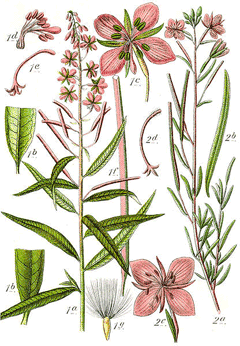
(PFAF)
Fireweed is a robust perennial, growing .5-3m tall. It has fine roots and rhizomes, extending down to 45cm in the soil, purplish stems, narrow leaves around 3-20cm long, pink/magenta four-petalled flowers ~2-3cm in diameter, and long slender fruits of a similar colour to the flower. In late summer when the fruits dry they burst open and release long-haired seeds to the wind. The plant can reproduce both sexually (through flowering) and asexually (vegetative reproduction through rhizomes), depending on climate and environmental pressures. So awesome! Imagine if we could do that.
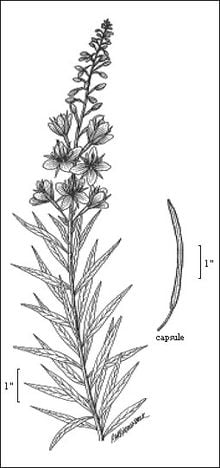
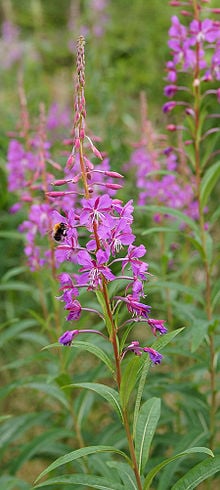
In addition to the leaves being used for tea, different parts of the plant have been used for food and medicine by people around the Northern Hemisphere where it is found: the young shoots as a vegetable similar to asparagus, the young leaves as a green, the roots as another vegetable and sometimes roasted and brewed as a coffee substitute (best before the plant flowers), the flowers made into jelly (ibid.). The plant has been used in both European and North American folk medicine traditions to soothe skin irritation and burns, and brewed into a tea to relieve stomach upset, respiratory difficulties, constipation, prostate conditions and urinary difficulties (PFAF, 2012). There is even production of monofloral fireweed honey in Alaska, as well as reports of an ale made with fireweed in Kamchatka, whose intoxicating factor was bolstered with the addition of the hallucinogenic fly agaric mushroom Amanita muscaria.
Other non-edible uses include cordage from the fibre of the outer stems, stuffing material and tinder from the seed hairs, and a protection from the cold from the powdered inner cortex when applied to exposed skin. At one point some enterprising Swedes tried to make a cotton-like textile from the fibrous seed hairs, but it didn’t work so well (Ljungqvist, 2011).
Fireweed is common in a variety of ecosystems: by streams, in uplands, coniferous and mixed forests, aspen parklands, grasslands, and bogs. It quickly colonises disturbed habitats, such as logged areas, deglaciated land, avalanche zones, highway and railway embankments, old fields, and burned areas (hence ‘fireweed’). During the Second World War, fireweed also came to be known as ‘bombweed’ due to its proliferation in bomb craters. The plant can handle shade but grows best in open locations with direct light, and prefers acidic soil. It is easily cultivated, growing best in soil with good drainage but that also retains moisture, yet it can also grow in many other conditions. It is hardy to -20˚C. Fireweed is currently only cultivated as a soil stabiliser, and because of its widespread distribution across the Northern Hemisphere it is quite easily harvested locally, including in Denmark and Scandinavia.
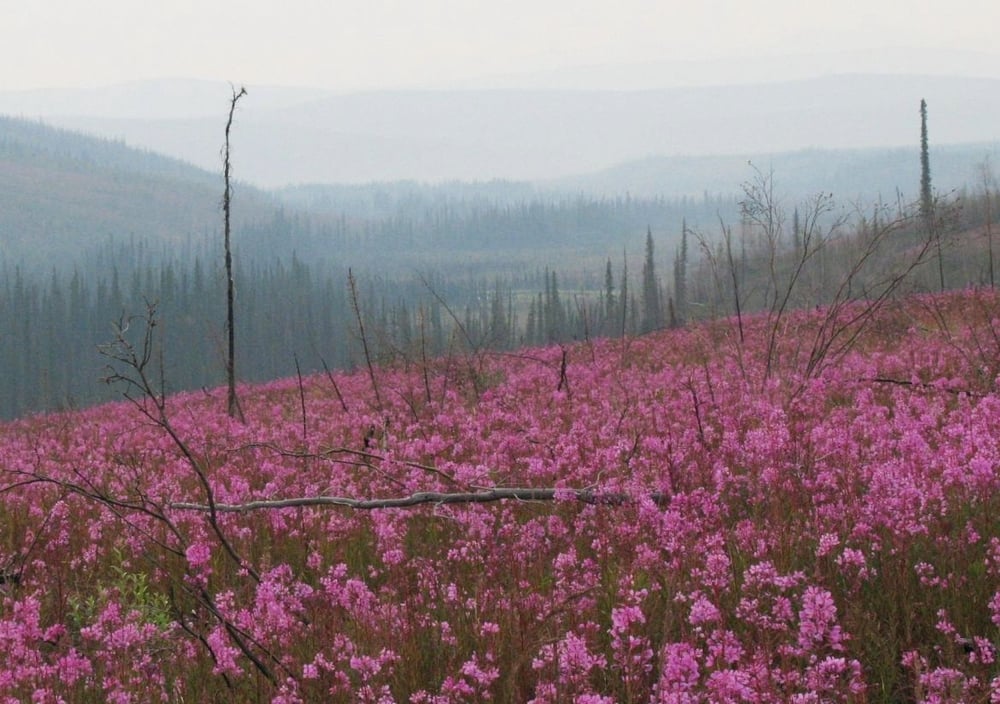
Fireweed after a forest fire.
I learned about fireweed in the middle of the summer 2013, too late to work with the tender young shoots and barely catching the end of the younger leaves—the best candidates for making tea. The younger leaves can be quite delicate, with a bright, fresh-olive aroma and a slight bitterness. The flowers are gently fragrant with a hint of sweetness. When oxidised, the leaves take on a dark colour and various notes of black tea and fruit. When fermented, they develop notes of fermented olives and brine. I began working with more mature specimens to get a feel for the plant and how it responded to the technique, making trials on how to initiate, direct and stop oxidation, and bode my time until the following season.
At the end of the summer, I took a trip to the Danish island of Bornholm with my friend Josh Pollen (he’s a chef in London who runs Blanch & Shock together with his partner Mike Knowlden, and he’s spent some time with us before). We spent three days biking around the island, eating mirabelles, getting lost on logging roads, and camping on the beach. It is a beautiful island.
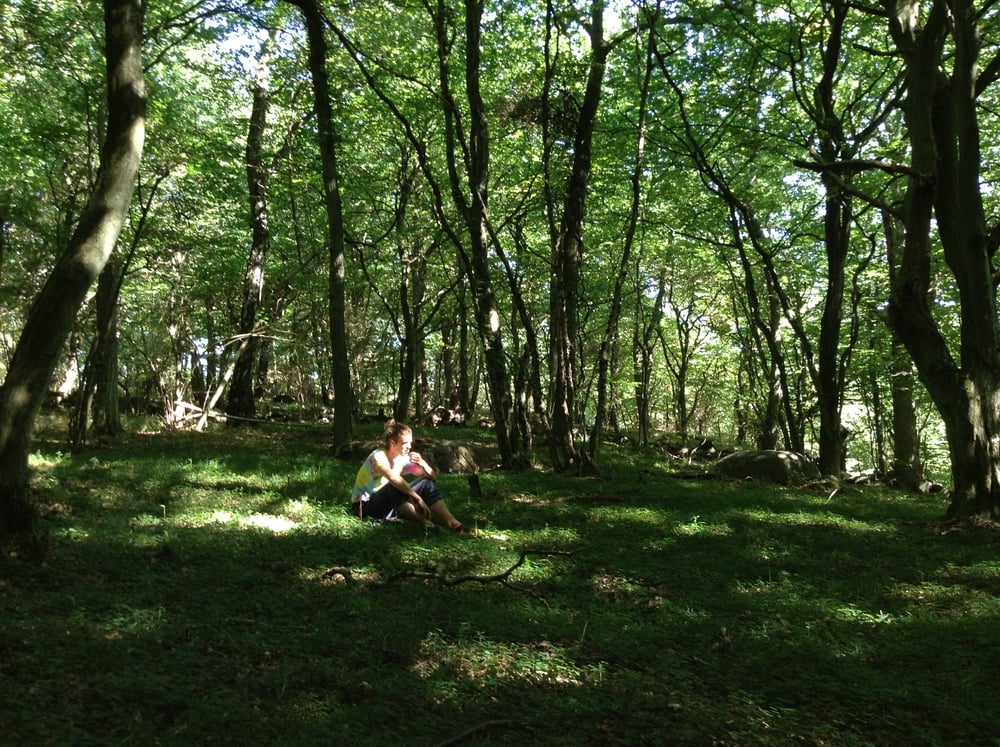
Josh chilling in a sea of wood sorrel
On our last night, we went to Kadeau Bornholm, the first time for us both. After our meal, we hung out with some of the team, and when we told them we were sleeping in the beach dunes below the restaurant that night they invited us to staff breakfast the following morning. After breakfast, Markus Junkala, one of the sous-chefs who has since become a great collaborator, gave us a tour and showed us a bunch of things they were working on, one of which was——fireweed tea! The coincidence was too funny. We agreed once the season had finished on the island, we would meet back in Copenhagen and plan some collaborative R&D for the spring.
Part 3—Making tea
At the start of June 2014 I went to Bornholm to work further with Markus on developing a fireweed tea we wanted to drink. Here are my tea-related notes from that time.
6.6.14
tea – focus on fireweed. start with oxidation, develop technique. then layer A. niger on top. to serve alone, in a blend, and also to make a variety.

Markus leading the way to forage beach coriander.
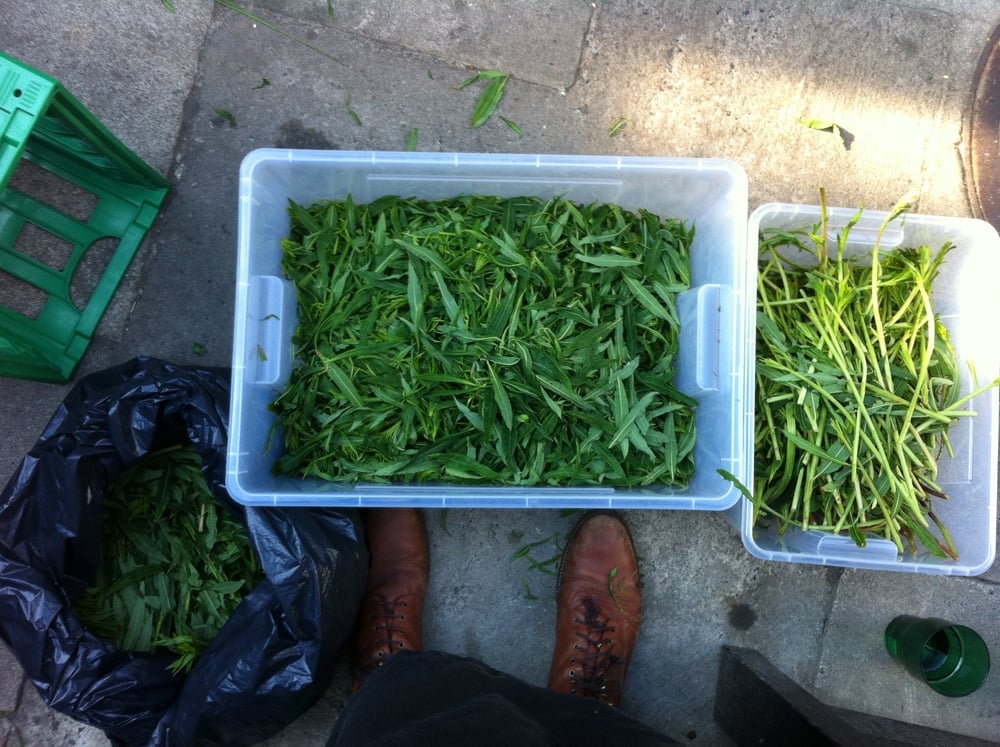
Fireweed leaves stripped from the stem
7.6.14
fireweed. harvested kl.930. left in plastic garbage bag all day to begin to wilt. picked leaves at kl.18, crushed by hand, oxidation begun kl.19. bashed with rolling pins in gastros kl.23 to increase oxidation (the kitchen guys thought we were crazy).
The plan for the fireweed is to do a bit more of a structured process, to figure out what we think works best. So far, our variables are:
fermentation method: under weight, under vacuum
fermentation time: 2 days, 3 days
fermentation halting method: dehydrating, sun-drying, steaming, roasting
This matrix yields 16 trials.
Other possible variables to explore include oxidation method, oxidation time, fermentation temperature, storage method, and post-fermentation moulding with A. niger.
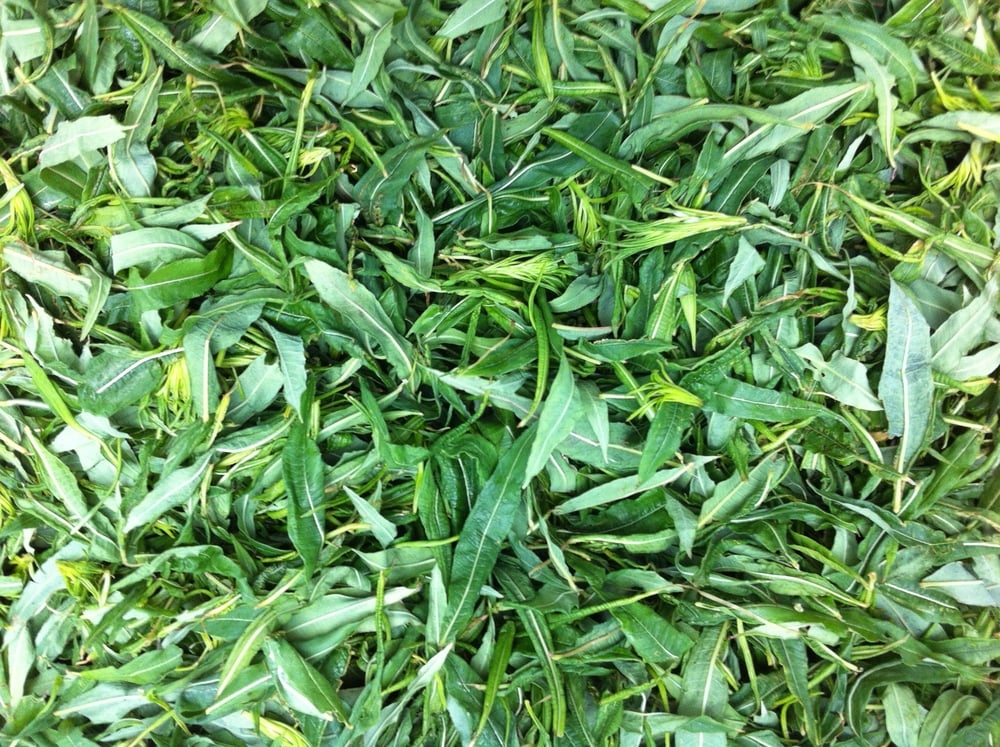
Fireweed leaves ready to begin oxidation.
8.6.14
fireweed tea – begun fermentations kl.1030.
9.6.14
fireweed tea – quite aromatic actually. tasted and taken off fermenting kl 17.
fireweed – Markus will split batches tuesday[10.7]/wednesday[11.7] into 4 and stop fermentation using 4 methods: dehydrate, sun-dry, steam, roast. label, vacuum and freeze until tasting.
Over those few days in June the weather was glorious, sunny and hot—hence our optimism and excitement with being able to use sun-drying as a processing method. On Tuesday the 10th and Wednesday the 11th, however—the days Markus was to halt the fermentation—the sun had disappeared, so he removed the ‘sun-dried’ variable from the trials. Which was just as well because nine trials was enough for one tasting, let alone sixteen.
I returned for a few days in the middle of July to work further.
14.7.14
the onion cress tea worked last time![summer 2013 by Markus] try with more alliums, maybe green leek tops
fireweed – keeping flowers in yields red berry smells
15.7.14
[This day we conducted a tasting trial, along with Nicolai, Magnus and Rasmus, the trio behind the restaurant. We also began applying the techniques to plants other than fireweed to see what happened]
tea taste trial. 8 fireweed trials + 1 just lightly oxidised version:


Trials for double-blind tasting 1, July 2014 at Kadeau Bornholm, with unfermented control (#9). Two brewings were tasted, and none from the second were preferred. If only I knew how to represent matrices in three dimensions, it would be much prettier..
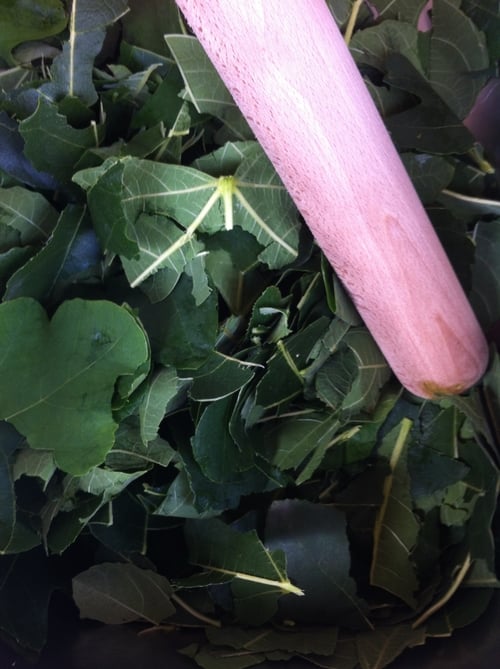
Bashing fig leaves with a rolling pin. A bit crude, but it was a first trial..
trials 1 and 7 are best for further development, as well as 2 and 9. It seems the non-vacced are preferred, with the steamed preferred at 2 days and the roasted at 3. [This could be because the container-fermented leaves have more internal variability and thus develop a greater range of flavour, whereas the vacuum-sealed leaves have quite a consistent environment and so the range is more narrow.. just a hypothesis.. in any case the more delicate flavour after 2 days makes more sense for steaming, and the stronger flavour after 3 for roasting. The best steamed trials were appreciated for their balanced taste and herbal/floral notes, while the best roasted trials were enjoyed for their fuller tannins and noted similarity to earl grey.]
processing other teas: fig leaf, kohlrabi leaf, meadowsweet leaves, angelica leaves, tansy leaves. started oxidising, and fermenting at end of night.
17.7.14
teas – more control trials of lightly oxidised then dried/steamed; and further trials with the flowers: with leaves included during oxidation/fermentation, as well as excluded, dried and then added to the processed tea.
other teas: post-fermentation processing for fig leaf, meadowsweet, tansy, kohlrabi. the kohlrabi is disgusting and farty and rotten – tossed. the meadowsweet isn’t so fermented, it is quite sturdy – sealed full and kept longer.
11.11.14
TEA TASTING:
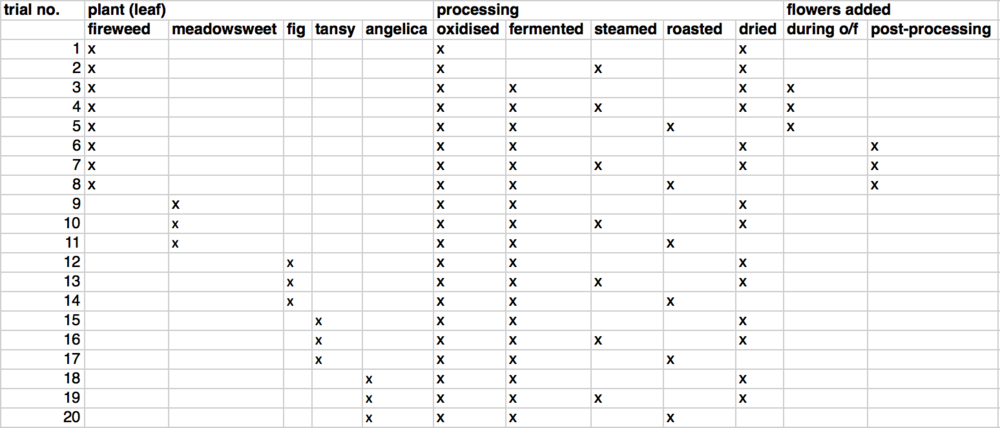
Trials for blind tasting 2, November 2014 at Kadeau København. Two brewings were tasted. All trials had standard 2-day fermentation in container.
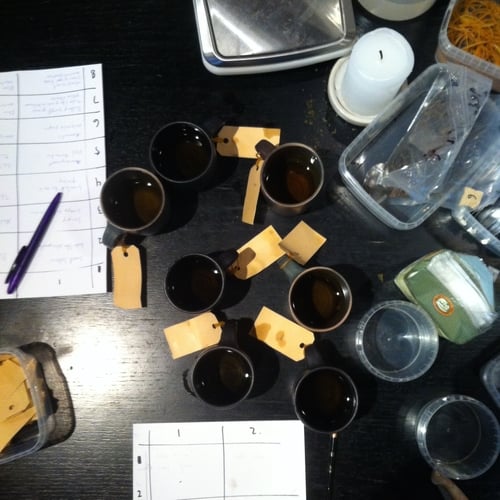
brewing method: 2.5g in bag / 100ml, pulled at 1 min; re-brewed
Results:
with flowers – we seem to prefer roasted ones (batches 5 and 8), as well as batch 6, with dried flowers added after fermentation and drying. in general, those processed with flowers (3-5) get too soapy. 6 may be better in second brewing, lactic notes are more mild. otherwise, 1st brewing is best and very aromatic.
meadowsweet – 9 (ofd) is best. the others lose the meadowsweet flavour. perhaps needs less processing eg. only 1 day fermentation.
fig – 12 (ofd) is horrible; 13 (ofsd) is better and preserves some of the fig/coconut flavour. none are good enough by themselves, maybe blended with other teas, and/or with fresh leaves. or maybe tincture is just better for the fig leaf!
tansy – amazing smells! all so incredibly bitter! perfect rotovap potential, to separate the top notes from the bitter taste compounds.
angelica – definitely savoury broth territory. 19 (ofsd) and 20 (ofr) are best, and give a fantastic tingling sensation. could be great mixed with fresh/dried angelica leaves for more of those angelica top notes. these have loads of body. use with something fatty! like pork, or lamb neck.
By this point we had gained a few different directions to take the research: developing a tea to drink, especially as a post-prandial; and using a similar technique to supercharge the flavours of many different plants for savoury applications—especially plants, like fireweed, that don’t have so much flavour in their raw form, or have a nice aroma but a tough, sturdy, or fibrous texture that does not lend the leaves well to being eaten directly, either raw or cooked (like fig leaves, and mature leaves of tansy, angelica, meadowsweet, and many others).
And now, at last, a recipe. Here is the protocol Markus and I developed for a basic fireweed tea, which can be conjugated further for all sorts of other plants.
Fireweed tea
1. Harvest a bunch of fireweed. Cut the stalk just below the last useable leaf—depending on the fineness of the tea this could be anywhere from just the tip to the tenth leaf or more.
2. Pick. Bring the fireweed back to your working area. Pick off the leaves from the stem, and, if wanting to make different grades, sort into different sizes. Discard any leaves that are brown, dried, or otherwise not intact.
3. Oxidise. Depending on the amount of leaves and available time, this can be done by rolling and/or crushing the leaves with one’s hands, bashing them with a rolling pin in a gastrotray, or other methods which we invite you to dream up.
4. Develop flavour. Let the leaves sit to oxidise and develop flavour—this length of time can be however long or short one prefers, although we tended to let it go for at least a couple hours and no more than twelve. We found the tea turned out best when the oxidising leaves were at the height of aromatic intensity.
5. Ferment. Put the oxidised leaves into a container and place another container of identical size on top, pressing firmly so the leaves compact and become more or less ‘sealed’ in the bottom container. Allow the leaves to ferment at ambient temperature for 2-3 days (or less or more) depending on the plant and the desired result.
6. Halt fermentation. Once the leaves have fermented, remove from the container and halt the fermentation by dehydrating, steaming, roasting, or any other technique you prefer for dispatching bacteria (except maybe not bleach).
7. Store. Once the fermenting leaves have been turned into non-fermenting leaves, ensure the leaves are sufficiently dry and have cooled to ambient temperature, then store. We prefer sealing at partial vacuum (to remove as much air from the bag as possible without crushing the leaves) and keeping cool and dark, to prevent further oxidation from light, heat, or oxygen or from taking up other unwanted aromas.
8. Brew. The standard procedure for (black) tea sensory analysis (I have since read) is 3g of tea to 150mL boiling water, infused for 5 minutes then poured for evaluation (Kan et al., 2004). Of course, one may brew the tea however one may wish, which will also change depending on the processing method (we have found toasted/roasted teas can handle higher brewing temperatures), the desired profile, and the culinary function.
Future things to test:
– separate fireweed leaves into different grades depending on the size and conditions of harvest, as do producers of high-quality tea
– sun-drying versus dehydrating to halt fermentation
– different oxidation methods
– different oxidation times
– different fermentation temperatures (all of these trials were conducted at warm summer room temperature, mid-to-high 20s)
– different post-processing storage methods (these trials were sealed with a partial vacuum and stored in the freezer)
– try all sorts of tough plants with flavour potential, especially parts of plants often thrown away like tough parts of leeks, tomato leaves, etc.
– and last but not least, now we have a method to which to add the extra layer of fermentation with Aspergillus niger! I want to make fireweed Pu-erh, build a pressing mould and press it into bricks, age it and see what happens—that’s what’s next..
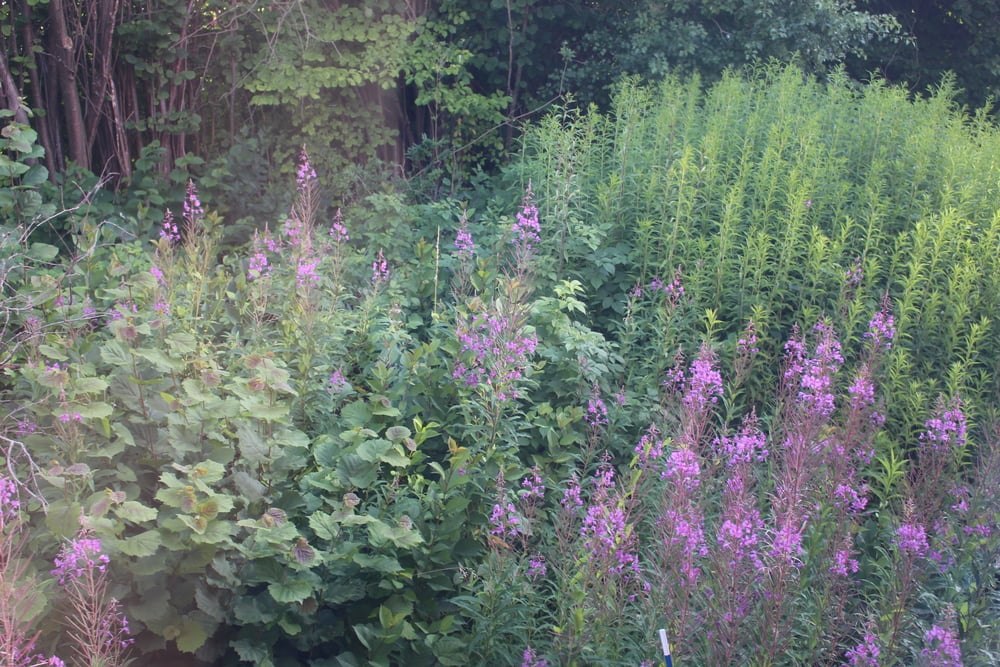
Fireweed outside the window of the train, north of Copenhagen. Now I see fireweed everywhere I go..
Acknowledgements
Many thanks to:
Sara Landvik for plating up our sources of Aspergillus niger;
Josh Pollen as the quintessential comrade;
Markus Junkala for being a brilliant partner-in-crime;
Nicolai Nørregaard and the whole team at Kadeau for hosting me and giving me and Markus time and space to carry out our research on Bornholm and in Copenhagen;
Max McCurdy in Tokyo for that memorable pu-erh-fueled evening in November 2014;
and of course many members of the NFL team past and present.
References
Blumenthal, Cynthia. 2004. Production of toxic metabolites in Aspergillus niger, Aspergillus oryzae, and Trichoderma reesei: justification of mycotoxin testing in food grade enzyme preparations derived from the three fungi. Regulatory Toxicology and Pharmacology. 39: 214-228.
‘Chamerion angustifolium’. Wikipedia. Accessed 12.1.16. <https://en.wikipedia.org/wiki/Chamerion_angustifolium>.
‘Chamerion angustifolium (L.) Holub (Fireweed)’. Agriculture and Agri-Food Canada. Government of Canada. Updated 23.1.2012. Accessed 19.11.13. <http://www.agr.gc.ca/eng/science-and-innovation/science-publications-and-resources/resources/canadian-medicinal-crops/medicinal-crops/chamerion-angustifolium-l-holub-fireweed/?id=1300903819413>.
‘Epilobium angustifolium L.’. Plants for a Future. Updated 2012. Accessed 19.11.13. <pfaf.org/user/Plant.aspx?LatinName=Epilobium+angustifolium>.
Kan, Tze-Neng et al. ‘Chapter 46: Partially Fermented Tea’. In Handbook of Food and Beverage Fermentation Technology, ed. Y.H. Yui et al. New York: Marcel Dekker, 2004.
Ljungqvist, Kerstin. 2011. ‘Mjölkört’. Nyttans Växter. Calluna: Sweden. pp297-8.
